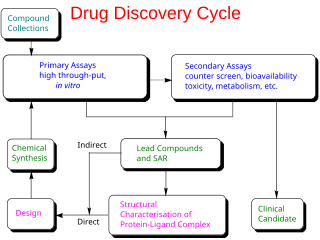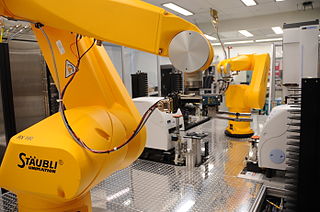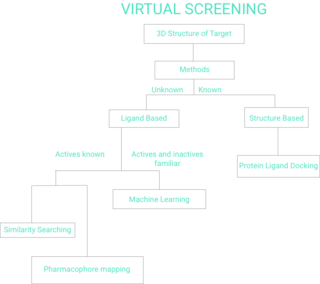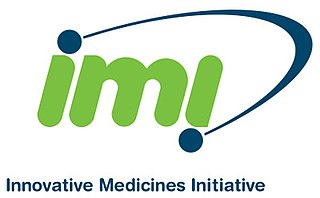Related Research Articles
Combinatorial chemistry comprises chemical synthetic methods that make it possible to prepare a large number of compounds in a single process. These compound libraries can be made as mixtures, sets of individual compounds or chemical structures generated by computer software. Combinatorial chemistry can be used for the synthesis of small molecules and for peptides.

In the fields of medicine, biotechnology and pharmacology, drug discovery is the process by which new candidate medications are discovered.

Drug design, often referred to as rational drug design or simply rational design, is the inventive process of finding new medications based on the knowledge of a biological target. The drug is most commonly an organic small molecule that activates or inhibits the function of a biomolecule such as a protein, which in turn results in a therapeutic benefit to the patient. In the most basic sense, drug design involves the design of molecules that are complementary in shape and charge to the biomolecular target with which they interact and therefore will bind to it. Drug design frequently but not necessarily relies on computer modeling techniques. This type of modeling is sometimes referred to as computer-aided drug design. Finally, drug design that relies on the knowledge of the three-dimensional structure of the biomolecular target is known as structure-based drug design. In addition to small molecules, biopharmaceuticals including peptides and especially therapeutic antibodies are an increasingly important class of drugs and computational methods for improving the affinity, selectivity, and stability of these protein-based therapeutics have also been developed.

High-throughput screening (HTS) is a method for scientific discovery especially used in drug discovery and relevant to the fields of biology, materials science and chemistry. Using robotics, data processing/control software, liquid handling devices, and sensitive detectors, high-throughput screening allows a researcher to quickly conduct millions of chemical, genetic, or pharmacological tests. Through this process one can quickly recognize active compounds, antibodies, or genes that modulate a particular biomolecular pathway. The results of these experiments provide starting points for drug design and for understanding the noninteraction or role of a particular location.
Astex Pharmaceuticals ("Astex") is a biotechnology company focused on the discovery and development of drugs in oncology and diseases of the central nervous system. Astex was founded in 1999 by Sir Tom Blundell, Chris Abell & Harren Jhoti, and is located in Cambridge, England.
The Structural Genomics Consortium (SGC) is a public-private-partnership focusing on elucidating the functions and disease relevance of all proteins encoded by the human genome, with an emphasis on those that are relatively understudied. The SGC places all its research output into the public domain without restriction and does not file for patents and continues to promote open science. Two recent publications revisit the case for open science. Founded in 2003, and modelled after the Single Nucleotide Polymorphism Database (dbSNP) Consortium, the SGC is a charitable company whose Members comprise organizations that contribute over $5,4M Euros to the SGC over a five-year period. The Board has one representative from each Member and an independent Chair, who serves one 5-year term. The current Chair is Anke Müller-Fahrnow (Germany), and previous Chairs have been Michael Morgan (U.K.), Wayne Hendrickson (U.S.A.), Markus Gruetter (Switzerland) and Tetsuyuki Maruyama (Japan). The founding and current CEO is Aled Edwards (Canada). The founding Members of the SGC Company were the Canadian Institutes of Health Research, Genome Canada, the Ontario Research Fund, GlaxoSmithKline and Wellcome Trust. The current Members comprise Bayer Pharma AG, Bristol Myers Squibb, Boehringer Ingelheim, the Eshelman Institute for Innovation, Genentech, Genome Canada, Janssen, Merck KGaA, Pfizer, and Takeda.

Virtual screening (VS) is a computational technique used in drug discovery to search libraries of small molecules in order to identify those structures which are most likely to bind to a drug target, typically a protein receptor or enzyme.
Hit to lead (H2L) also known as lead generation is a stage in early drug discovery where small molecule hits from a high throughput screen (HTS) are evaluated and undergo limited optimization to identify promising lead compounds. These lead compounds undergo more extensive optimization in a subsequent step of drug discovery called lead optimization (LO). The drug discovery process generally follows the following path that includes a hit to lead stage:

The European Federation of Pharmaceutical Industries and Associations (EFPIA) is a Brussels-based trade association and lobbying organisation, founded in 1978 and representing the pharmaceutical industry operating in Europe. Through its membership of 36 national associations and 39 leading pharmaceutical companies, the EFPIA represents 1,900 European companies.

Barend Mons is a molecular biologist by training and a leading FAIR data specialist. The first decade of his scientific career he spent on fundamental research on malaria parasites and later on translational research for malaria vaccines. In the year 2000 he switched to advanced data stewardship and (biological) systems analytics. He is currently a professor in Leiden and most known for innovations in scholarly collaboration, especially nanopublications, knowledge graph based discovery and most recently the FAIR data initiative and GO FAIR. Since 2012 he is a Professor in biosemantics in the Department of Human Genetics at the Leiden University Medical Center (LUMC) in The Netherlands. In 2015 Barend was appointed chair of the High Level Expert Group on the European Open Science Cloud. Since 2017 Barend is heading the International Support and Coordination office of the GO FAIR initiative. He is also the elected president of CODATA, the standing committee on research data related issues of the International Science Council. Barend is a member of the Netherlands Academy of Technology and Innovation(ACTI). He is also the European representative in the Board on Research Data and Information (BRDI) of the National Academies of Science for engineering and medicine in the USA. Barend is a frequent keynote speaker about FAIR and open science around the world, and participates in various national and international boards.
A lead compound in drug discovery is a chemical compound that has pharmacological or biological activity likely to be therapeutically useful, but may nevertheless have suboptimal structure that requires modification to fit better to the target; lead drugs offer the prospect of being followed by back-up compounds. Its chemical structure serves as a starting point for chemical modifications in order to improve potency, selectivity, or pharmacokinetic parameters. Furthermore, newly invented pharmacologically active moieties may have poor druglikeness and may require chemical modification to become drug-like enough to be tested biologically or clinically.

The Innovative Medicines Initiative (IMI) is a European initiative to improve the competitive situation of the European Union in the field of pharmaceutical research. The IMI is a joint initiative of the DG Research of the European Commission, representing the European Communities, and the European Federation of Pharmaceutical Industries and Associations (EFPIA). IMI is laid out as a Joint Technology Initiative within the Seventh Framework Programme. Michel Goldman was the first executive director, from September 2009 until December 2014.
High throughput biology is the use of automation equipment with classical cell biology techniques to address biological questions that are otherwise unattainable using conventional methods. It may incorporate techniques from optics, chemistry, biology or image analysis to permit rapid, highly parallel research into how cells function, interact with each other and how pathogens exploit them in disease.
Fragment-based lead discovery (FBLD) also known as fragment-based drug discovery (FBDD) is a method used for finding lead compounds as part of the drug discovery process. Fragments are small organic molecules which are small in size and low in molecular weight. It is based on identifying small chemical fragments, which may bind only weakly to the biological target, and then growing them or combining them to produce a lead with a higher affinity. FBLD can be compared with high-throughput screening (HTS). In HTS, libraries with up to millions of compounds, with molecular weights of around 500 Da, are screened, and nanomolar binding affinities are sought. In contrast, in the early phase of FBLD, libraries with a few thousand compounds with molecular weights of around 200 Da may be screened, and millimolar affinities can be considered useful. FBLD is a technique being used in research for discovering novel potent inhibitors. This methodology could help to design multitarget drugs for multiple diseases. The multitarget inhibitor approach is based on designing an inhibitor for the multiple targets. This type of drug design opens up new polypharmacological avenues for discovering innovative and effective therapies. Neurodegenerative diseases like Alzheimer’s (AD) and Parkinson’s, among others, also show rather complex etiopathologies. Multitarget inhibitors are more appropriate for addressing the complexity of AD and may provide new drugs for controlling the multifactorial nature of AD, stopping its progression.
Phenotypic screening is a type of screening used in biological research and drug discovery to identify substances such as small molecules, peptides, or RNAi that alter the phenotype of a cell or an organism in a desired manner. Phenotypic screening must be followed up with identification and validation, often through the use of chemoproteomics, to identify the mechanisms through which a phenotypic hit works.
Open PHACTS was a European initiative public–private partnership between academia, publishers, enterprises, pharmaceutical companies and other organisations working to enable better, cheaper and faster drug discovery. It has been funded by the Innovative Medicines Initiative, selected as part of three projects to "design methods for common standards and sharing of data for more efficient drug development and patient treatment in the future".

eTOX is a temporary consortium established in 2010 to share and use toxicology data. It is a pre-competitive collaboration which main goal is to create and distribute tools to predict drug side-effects based on pre-clinical experiments. Aims are a better in silico predictability of potential adverse events and a decrease of the use of animals in toxicological research. eTOX is funded by the Innovative Medicines Initiative (IMI).

James Inglese is an American biochemist, the director of the Assay Development and Screening Technology laboratory at the National Center for Advancing Translational Sciences, a Center within the National Institutes of Health. His specialty is small molecule high throughput screening. Inglese's laboratory develops methods and strategies in molecular pharmacology with drug discovery applications. The work of his research group and collaborators focuses on genetic and infectious disease-associated biology.

Gerardo Turcatti is a Swiss-Uruguayan chemist who specialises in chemical biology and drug discovery. He is a professor at the École Polytechnique Fédérale de Lausanne (EPFL) and director of the Biomolecular Screening Facility at the School of Life Sciences there.
Viness Pillay FAAS (1970–2020) was a South African professor of pharmacy at the University of the Witwatersrand in Johannesburg. He was the Director of the Wits Advanced Drug Delivery Platform (WADDP), a member of African Academy of Sciences, Academy of Translational Medicine Professionals (ATMP) and a beneficiary of the 2013 Olusegun Obasanjo Innovative Award for developing the RapiDiss Wafer Technology as an innovative way to provide effective anti-retroviral (ARV) drug therapy to children afflicted with HIV/AIDS.
References
- ↑ "IMI Innovative Medicines Initiative - ELF - European Lead Factory". IMI Innovative Medicines Initiative.
- ↑ "The vital role of SMEs in medical research". euronews. 2016-12-28. Retrieved 2017-05-17.
- ↑ "Partners - European Lead Factory". www.europeanleadfactory.eu.
- ↑ "Joint European Compound Library - European Lead Factory". www.europeanleadfactory.eu. Archived from the original on 2017-04-25. Retrieved 2017-02-20.
- ↑ "EU Screening Centre - European Lead Factory". www.europeanleadfactory.eu. Archived from the original on 2017-04-29. Retrieved 2017-02-20.
- ↑ Karawajczyk, Anna; Orrling, Kristina M.; Vlieger, De; B, Jon S.; Rijnders, Ton; Tzalis, Dimitrios (2017). "The European Lead Factory: A Blueprint for Public–Private Partnerships in Early Drug Discovery". Frontiers in Medicine. 3: 75. doi: 10.3389/fmed.2016.00075 . ISSN 2296-858X. PMC 5243859 . PMID 28154815.
- ↑ The European Lead Factory – An experiment in collaborative drug discovery - Laverty HG, et al., Journal of Medicines Development Sciences 1.1 (2015), doi: 10.18063/JMDS.2015.01.009
- ↑ Besnard, Jérémy; Jones, Philip S.; Hopkins, Andrew L.; Pannifer, Andrew D. (2015-02-01). "The Joint European Compound Library: boosting precompetitive research". Drug Discovery Today. 20 (2): 181–186. doi: 10.1016/j.drudis.2014.08.014 . ISSN 1359-6446. PMID 25205347.
- ↑ Karawajczyk, Anna; Giordanetto, Fabrizio; Benningshof, Jorg; Hamza, Daniel; Kalliokoski, Tuomo; Pouwer, Kees; Morgentin, Remy; Nelson, Adam; Müller, Gerhard (2015-11-01). "Expansion of chemical space for collaborative lead generation and drug discovery: the European Lead Factory Perspective". Drug Discovery Today. 20 (11): 1310–1316. doi: 10.1016/j.drudis.2015.09.009 . ISSN 1359-6446. PMID 26429298.
- ↑ Jones, Philip; McElroy, Stuart; Morrison, Angus; Pannifer, Andrew (2015-09-01). "The importance of triaging in determining the quality of output from high-throughput screening". Future Medicinal Chemistry . 7 (14): 1847–1852. doi: 10.4155/fmc.15.121 . ISSN 1756-8919. PMID 26419190.